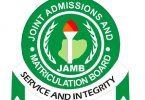Jamb Chemistry Exam Questions and Answers for free for all Jamb candidates are now available. The Jamb Chemistry exam questions are now trending online, you can use them for guidelines to study.
Jamb exam questions are logical in the sense that all the answers option look alike or exactly which made it so confusing and make many candidates fail.
Jamb Chemistry exam questions are not hard or difficult, you can use a sample of our Jamb Chemistry exam questions and answers available here for guides.
If you have not still covered the 2023 Jamb Chemistry syllabus kindly do because Jamb we set questions from the syllabus. You only need to read using the JAMB Chemistry syllabus as a guide to know the JAMB topics to cover before the Jamb exam day.
Jamb Chemistry Exam Questions and Answers For All Jamb Candidates
1. Which of the following statements is NOT correct?
A. The average kinetic energy of a gas is directly proportional to its temperature
B. At constant temperature, the volume of a gas increases as the pressure increases
C. The pressure of a gas is inversely proportional to its volume
D. The temperature of a gas is directly proportional to its volume
Correct Answer: B
2. Zinc Oxide is a
A. Basic Oxide
B. Acidic Oxide
C. Amphoteric Oxide
D. Neutral Oxide
Correct Answer: C
3. When sodium chloride and metallic sodium are each dissolved in water
A. both processes are exothermic
B. both processes are endothermic
C. the dissolution of metallic sodium is endothermic
D. the dissolution of metallic sodium is exothermic
E. the dissolution of sodium chloride is explosive
Correct Answer: D
4. The periodic classification of elements is an arrangement of the elements in order of their
A. Atomic Weights
B. Isotopic Weights
C. Molecular Weights
D. Atomic Numbers
Correct Answer: D
5. In the reaction between sodium hydroxide and sulphuric acid solutions, what volume of 0.5 molar sodium hydroxide would exactly neutralise 10cm3 of 1.25 molar sulphuric acid?
A. 5cm3
B. 50cm3
C. 20cm3
D. 25cm3
Correct Answer: B
6. A small quantity of solid ammonium chloride (NH4Cl) was heated gently in a test tube, the solid gradually disappears to produce two gases. Later, a white cloudy deposit was observed on the cooler part of the test tube. The ammonium chloride is said to have undergone
A. distillation
B. sublimation
C. precipitation
D. evaporation
Correct Answer: B
7. Elements P, Q, R, S have 6, 11, 15, 17 electrons respectively, therefore,
A. P will form an electrovalent bond with R
B. Q will form a covalent bond with S
C. R will form an electrovalent bond with S
D. Q will form an electrovalent bond with S
Correct Answer: D
8. An element X forms the following compounds with chlorine; XCl4, XCl3, XCl2. This illustrates the
A. law of multiple proportions
B. law of chemical proportions
C. law of simple proportions
D. law of conservation of mass
Correct Answer: A
9. The oxidation state of chlorine in potassium chlorate is
A. +1
B. +2
C. +3
D. +5
Correct Answer: D
10.When air which contains the gases Oxygen, nitrogen, carbondioxide, water vapour and the rare gases, is passed through alkaline pyrogallol and then over quicklime, the only gases left are;
A. nitrogen and carbon dioxide
B. the rare gases
C. nitrogen and oxygen
D. nitrogen and the rare gases
Correct Answer: D
11. When heat is absorbed during a chemical reaction, the reaction is said to be
A. thermodynamic
B. exothermic
C. isothermal
D. endothermic
Correct Answer: D
12. When large hydrocarbon molecules are heated at high temperature in the presence of a catalyst to give smaller molecules, the process is known as
A. disintegration
B. polymerization
C. cracking
D. degradation
Correct Answer: C
13. The pH of four solutions W, X, Y, Z are 4, 6, 8, 10 respectively, therefore
A. none of these solutions is acidic
B. the pH of Y is made more acidic by addition of distilled water
C. Z is the most acidic solution
D. W is the most acidic solution
Correct Answer: D
14. When each of the nitrates of Potassium, Magnesium and iron is heated
A. all the nitrates decompose to their oxides
B. the nitrate of magnesium gives the nitrite and oxygen
C. the nitrates of iron magnesium and iron give the oxides
D. the nitrate of iron gives the nitrite and oxygen
Correct Answer: C
15. Which of the following metals cannot replace hydrogen from water or steam?
A. Sodium
B. Copper
C. Iron
D. Calcium
Correct Answer: B
16. A sample of hard water contains some calcium sulphate and calcium hydrogen carbonate. The total hardness may therefore be removed by
A. boiling the water
B. adding excess calcium hydroxide
C. adding a calculated amount of calcium hydroxide
D. adding sodium carbonate
Correct Answer: D
17. During the electrolysis of copper II sulphate between platinum electrodes, if litmus solution is added to the anode compartment,
A. the litmus turns blue but no gas is evolved
B. the litmus turns blue and oxygen is evolved
C. the litmus turns blue and hydrogen is evolved
D. the litmus turns red and oxygen is evolved
Correct Answer: D
18. The reaction between an organic acid and an alcohol in the presence of an acid catalyst is known as;
A. saponification
B. dehydration
C. esterification
D. hydrolysis
Correct Answer: C
19. The IUPAC names of the compounds CH3COOH and CH2=CH2 are respectively;
A. acetic acid and ethene
B. ethanoic acid and ethene
C. methanoic acid and ethylene
D. ethanol and ethene
Correct Answer: A
20. If 30cm3 of oxygen diffuses through a porous pot in 7 seconds, how long will it take 60cm3 of chlorine to diffuse through the same pot, if the vapour densities of oxygen and chlorine are 16 and 36 respectively?
A. 9.3 sec
B. 14 sec
C. 21 sec
D. 28 sec
Correct Answer: C
21. Brass and bronze are both metallic alloys. Which of the following constituents is common to both alloys?
A. Tin
B. Zinc
C. Copper
D. Lead
Correct Answer: C
22. Which of the following gases may not be dried with concentrated sulphuric acid?
A. HCl
B. NH3
C. Cl2
D. SO2
Correct Answer: B
23. Which of the following reactions does not take place in the smelting of iron in a blast furnace?
A. CaCO3(s) CaO(s) + CO2(g)
B. C(s) + O2(g) CO2(g)
C. 3FeCO(s) + 2OCO2(g) FeO4(s)
D. SiO2(s) + CaO(s) CaCO3(s)
Correct Answer: C
24. Which of the following is not a member of the homologous series of the paraffins (alkanes)?
A. C24H48
B. C5H12
C. C7H16
D. C15H32
Correct Answer: A
25.When ammonia and hydrogen ion bond together to form ammonium ion, the bond formed is called
A. ionic bond
B. electrovalent bond
C. covalent bond
D. co-ordinate bond
Correct Answer: D
26. A second alkanol can be oxidized to give an
A alkanone
B alkyne
C alkanoic acid
D alkanal
Correct Answer: A
27 Which of the following will give a precipitate with an aqueous solution of copper (I) chloride?
A But-2-ene
B But-1-ene
C But-2-yne
D But-1-yne
Correct Answer: D
28 The IUPAC name for CH3CH2COOCH2CH3 is
A methylpropanoate
B ethylethanoate
C ethylpropanoate
D methylethanoate
Correct Answer: C
29 A certain hydrocarbon on complete combustion at s.t.p produced 89.6dm3 of CO2 and 54g of water. The hydrocarbon should be
A C6H6
B C4H10
C C5H10
D C4H6
Correct Answer: D
30 2-methylprop-1-ene is an isomer of
A 3-methyl but-1-ene
B 2-methyl but-1-ene
C but-2-ene
D pent-2-ene
Correct Answer: D
31 An example of an alcohol is
A. CCl4
B. CH3COOH
C. CHCl3
D. CH3OH
Correct Answer: D
32 The IUPAC name of the compound CF3 CHBrCl is
A 2-chloro-2-bromo-1,1,1-trifluoroethane
B 2-bromo-2-chloro-1,1,1-trifluoroethane
C 1-bromo-1-chloro-2,2,2-trifluoroethane
D 1,1,1-trifluoro-2-bromo-2-chloroethane
Correct Answer: B
33 Synthetic rubber is obtained from the polymerization of
A neoprene
B isoprene
C butandiene
D propylene
Correct Answer: B
34. Burning magnesium ribbon in air removes which of the following
(i) oxygen
(ii) nitrogen
(iii) argon and
(iv) carbon(iv)oxide?
A i and iv only
B i, ii, iii and iv only
C i only
D i and ii only
Correct Answer: C
35. Which of the following is the best starting material for the preparation of oxygen? Heating of trioxonitrate (v) with
A Pb
B Zn
C Ca
D Na
Correct Answer: A
36. The nucleus of an atom contains
A. protons only
B. neurons only
C. protons and Neutron
D. neutrons and electrons
E. protons and neutrons
Correct Answer: c
37. Hypochlorous acid is used as a bleach because
A. it is a strong acid
B. it yields chlorine readily in pure water
C. it is an oxidising agent
D. it is a weak acid
Correct Answer: C
38.The normal boiling point of a liquid is defined as
A. the temperature at which its vapour pressure equals the atmospheric pressure
B. the temperature at which bubbles begin to form
C. the temperature at which the vapour pressure equals 1 temperature
D. the temperature at which the rate of condensation of vapour equals the rate of vaporisation of the liquid
Correct Answer: C
39. Which of the following compounds will form a solution if exposed to air?
A.Na2CO3.10H2O
B.NaNO3
C.CuSO4
D.CaCl2
E.Na2SO4.10H2O
Correct Answer: D
40. The most common type of chemical reaction that alkanes undergo is
A. substitution
B. addition
C. condensation
D. polymerisation
Correct Answer: A
Kindly bookmark this link below for you are going to need it
- Latest Lists Of Universities That Write Post Utme Exam In Nigeria For 2023
- Top Universities that Accept Low Jamb Scores of 150, 160, 170…
- Nigeria Universities that Accepts Second Choice in Jamb For Direct Entry
If you have been wondering where to get the best and latest Jamb news updates and guide about Jamb 2023, how to pass Jamb, a timetable for Jamb Day 1, Day 2 Day 3 e.t.c, free online and hardcopy Jamb past questions, and hot topics to read for Jamb, and Jamb CBT practice platform, then subscribe to the newsletter or join our Forum
If actually, this information on Jamb Chemistry Exam Questions and Answers is awesome and useful to you please kindly share using via Facebook, WhatsApp, Twitter, and Google+








Thanks to the management team it was really helpful.
Nkedugists Team Appreciate.
Nice
Good, but i still need more explainations.
Nice 👍
Are these questions coming out on Tuesday
I don’t know yet
If I know everything here is it possible for me to pass my jamb
Thanks a million!!!
Is it legit?
Thanks for everything
Thanks
Thanks so much
No it’s not this is chemistry past questions for 1978…
Not for 2023